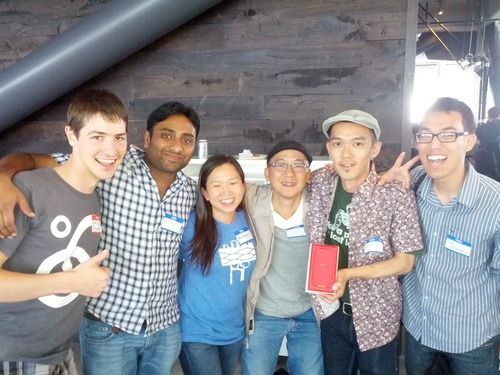High energy, high quality and high stakes. Photohack day 3 was all of that and more! Follow the discussion on HN
Photohack day 3 was the first edition on the west coast of the increasingly popular Photohack day hackathon put together by Aviary and its partners (Facebook, Dropbox, 500px, Samsung, Walgreens, Sincerely, Flickr, Flashphoto, Fujifilm, Tumblr & Filepicker.io). The previous two editions were on the east coast. Held on the 14th and 15th at Dropbox’s HQ in San Francisco, the event resulted in 70 awesome hacks over a 24 hour period. If you are looking for more details on the event and the hacks, we have added some public resources at the end of this post. The Facebook-Instagram acquisition has fueled renewed interest in the online photos market and some consider it an overcrowded space. But if the awesome hacks are any indication, then we are just getting started! The hacks revealed new use cases and possibilities of more things that we can do with photos. Here are the broad patterns we observed from the 70 hacks:
1. Augmented reality hacks: The hacks in this category broadly involved connecting the physical world with the digital world through photos. These hacks transferred properties from the photographs of real world objects so that that it could be digitally manipulated. One example that stood out was “ultimate Trace” that allowed users to take a photo, trace over it and perform other post processing functions with the Aviary API before publishing it via the Fujifilm and Walgreen’s API for monetization. Another impressive example was “SudokuGo”. With SudokuGo the user can snap pictures of half finished Sudoku games and have that transferred into an interactive Sudoku app on their phone/tablet or laptop. No more half-finished games! As the augmented reality space develops, we think photos will have a critical role to play in connecting the offline world to the online world.
2. Storyboard hacks: The hacks in this category focused on telling stories through photos. Some of the hacks weren’t limited to using static photos. “Just-a-second” was an interesting hack that took one second photos and put them together to form a collage which conveyed more emotions about the user’s experiences. “Storybook” written in HTML5/CSS3/JS took the traditional grid view of web albums in Facebook, Dropbox etc. and stitched the photos together to turn the photos into a visual flipbook much like the physical photo albums of the past.
3. Mashup hacks: The hacks in this category combined music, noise, photos and videos to deliver an immersive experience to the user. “Musipx” was super interesting. They created an automatic music visualization application by combining the lyrics of a song with publicly available photos. Imagine you are listening to Adele’s “Set fire to the rain” and you get pictures of rain droplets, fire in the background! The Musipix team combined elyrics with natural language processing before hooking the app up to image search APIs. Another interesting hack was “Another world” which combined the sounds & pictures of cafes, roadside noise, and BGM to turn your browser into a virtual cafe. The hack set the mood as if you were in your neighborhood cafe cranking on code.
4. Photo improvement hacks: This category probably saw the most numbers of hacks ranging from collaborative photo editing to a market place for photographers to provide photo editing services. “Touchmeup” focused on enabling casual photographers find somebody to touch up their photos while offering pro photoshoppers an opportunity to show off their skills while helping a friend out. Sizzly one of the winners of the grand prize was a social photo editing platform where users could upload photos from any device, share it via social circles so that collaborators could edit the photos and leave comments, and print it via walgreens and Fujifilm.
5. Memes: These there were the most fun hacks to watch. Eatmeme searched for a user’s twitter tags, mapped those tags to popular meme templates and slapped on the users tweet to the meme template. The best part was that it would then tweet the meme at the user! Our favorite one that won a Nexus7 tablet for the best use of the Filepicker.io API was “Photobomber”. With PhotoBomber, the user got an opportunity to have fun with his friend who was not physically with him. The user picks a friend’s photo, then selects a funny picture of himself from Dropbox, Facebook etc. using Filepicker.io that he resizes. Next, using FlashFoto to automatically crop his face, the user pastes his photo it in his friend’s picture, edits using Aviary’s API before sharing it on his social networks using Filepicker.io. Boom! The user just photobombed his friend. Congrats Abhishek, Phil, Blossom and Steve!
A complete list of all the hacks from Photohack Day 3 can be found here.
Some interesting hacks that used Filepicker.io include Sizzly, Eventbook, Cascade, Adhoc file transfer. Sizzly won the overall second prize and walked away some serious cash.
Brian, Paul and the rest of the team from Aviary did a kick ass job of putting together the event; tons of food, drinks to boot from Walgreens and other sponsors! We were super impressed that they stayed flexible and accommodating of requests through the stressful 24 hours when both the hackers and sponsors hardly rested! So if you are planning a hackathon soon, hit us up and we can hook you up with Brian @ Aviary. Also if you want us to post more about the hacks leave a comment.
Follow the discussion on HN
Filestack is a dynamic team dedicated to revolutionizing file uploads and management for web and mobile applications. Our user-friendly API seamlessly integrates with major cloud services, offering developers a reliable and efficient file handling experience.
Read More →